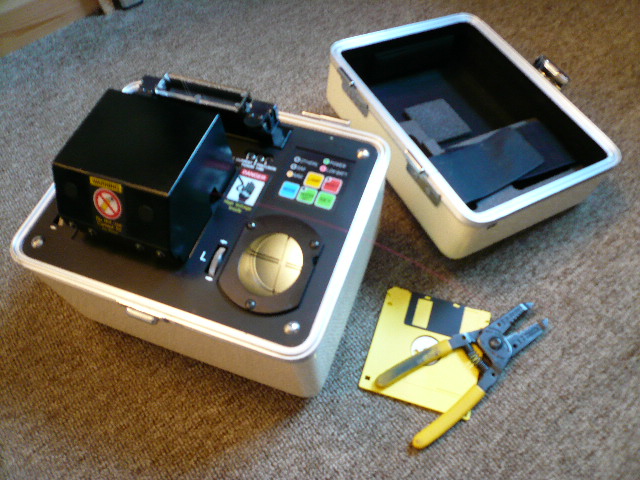What were the welders for optics

The development of technology leads to a decrease in the size of electronic devices. The same applies to devices for welding optical fibers. Once bulky colossi now fit in a small plastic case, and you can work with them in impassable attics and in damp basements. But let us return to the long years ago and take a look at the very same Mezozoi giants who were at the beginnings of the era of fiber-optic networks.
The need to develop a device that could connect optical fibers arose during the development of fiber optic transmitters and receivers and, of course, the fiber itself in the 70s of the last century. The first welder was used to work with multimode optical fibers with a relatively large core diameter of 50 microns. However, since the early 1980s, a welding machine for single-mode fibers was required. Despite the immense prospects for data transmission using light, manufacturers and scientists had enormous difficulties in developing equipment that could connect small fibers.
This is what one of the developers of the time from Fujikura said about this :
“All corporations working in this direction understood that a big business could be built on solving this problem! This is what really initially supported and promoted all research and development in the field of fiber welding. The idea was interesting, but it was not so easy to implement it. We began our research activities with a group of just three people. It was 1976. The development of optical fibers as such was still at the trial and error stage and besides the problems associated with the non-ideal fiber structure and its low strength, we didn’t even have an analytical approach to measuring the loss of light during its transmission through the fiber. In the course of work, a series of grueling experiments first followed; there was uncertainty about the future. At times it seemed to us that we would never achieve a breakthrough. Of course, This caused a great disappointment. However, next year, 1977, we finally saw a glimmer of hope. ”
Then the first experiments on the connection of fibers were carried out using two approaches: the mixing of the fibers and their gluing in a V-shaped groove; The second method was to fuse the fibers with an electric arc. Due to the excellent qualities and performance, the second method soon gained more development. Thus, the first model of a practical multimode Fujikura welding machine was completed in October 1977. Later, in 1979, this equipment was sent to an exhibition in Washington, DC, where the device stood in an unobtrusive corner of the exhibition hall, but gathered a crowd who wanted to look at this miracle of technology. Only a small photograph of this device has been preserved.

There was no great demand for the Japanese novelty, but the whole era began with the creation of this device. It is noteworthy that initially Fujikura considered the use of a “phase-contrast microscope” or “polarized microscope” for welding the fibers, so that the fiber core could be seen due to the difference in refractive indices. But both options were unsuccessful, because they simply were not suitable for introduction into a compact welding machine.
For about a year, dedicated researchers spent day and night in an experimental laboratory, working on the improvement and development of welding machine algorithms. All further developments were conducted in the strictest secrecy. As a result, a masterpiece was born in February 1985 - the welding machine was successfully put into practice for welding single-mode Fujikura FSM-20 fibers.





The device consisted of two separate blocks, which did not add to it the convenience and, all the more, any compactness. The main task of the developers at that time was to combine these two blocks into one device. At that time, Fujikura was not the only one engaged in the development of welding machines for optics. The well-known Siemens already in 1984 developed its own welding machine model M7.
It is necessary to carefully consider some models of welding machines of this particular company, because at the dawn of telecoms, Siemens devices could often be found on Russian open spaces.
Siemens RXS Siecor S46-999-M7-A10
In this video, you can see how the device works, and as seen in the fiber lens:


Siemens Fusion Splicer S46999-M7-A15





Siemens Fusion Splicer S46999-M7-A60




Siemens SIECOR X75 welding machine






SIEMENS RXS B-60
Portable American welding machine OP2090 from Power Technology Inc.
- OP2090Power Technology optical fiber splicer Model 310-01 portable.
- The allowable size of the fiber core diameter is 4-600 microns.
- The allowable size of the diameter of the fiber sheath is 80-600 microns.
- Weight - 19.5 kg.
- Nikon binocular microscope with a possibility of 40 or 80 times magnification.

The device company 3M, model 9500XFM


Sumitomo SUMIOFCAS


The article presented far from all rarity devices. Among the welding machines, dinosaurs can be found and interesting Soviet models, which, perhaps, will be written later.
